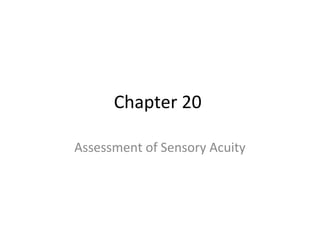
Ch20
- 1. Chapter 20 Assessment of Sensory Acuity
- 2. Why Assess Sensory Acuity? • Student impairments do not always require extensive assessment – Seemingly complex academic and behavioral problems may be rooted in sensory difficulties • Most common sensory difficulties – Vision – Hearing
- 3. Vision Difficulties • Types of visual impairment – Visual acuity • Clarity or sharpness of vision (20/20 v. 20/10 vision) – Field of vision • Tunnel vision • Scotoma – Imperfect color vision • Discrimination between hue, saturation, and brightness
- 4. Visual Acuity • Most serious as an educational problem if impairment occurs prior to age 5 • 5-33% of students are considered to be along the broad spectrum of “visually handicapped” – Blind – Low vision – Visually limited
- 5. Visual Acuity • Signs of visual impairment – Frequent headaches, dizziness, sensitivity to light, blurred vision – Obvious physical signs (e.g. red, swollen, or crossed eyes; haziness in pupils) – Behaviors: • Holding books too close to face while reading • Abnormal tilting of head • Poor alignment of words • Reluctance to participate in games requiring distance vision or visual accuracy
- 6. Vision Screening and Assessment • Screening – Standard Snellen Wall Chart • Limitations with school-age population • Referral rule of thumb: – 20/40 in either eye for K-3 children – 20/30 in either eye for older children – Snellen E Test • Used with children who are unable to rea – Keystone Telebinocular • Both Snellen tests are somewhat restricted in focus • Assesses 14 different visual skills • If visual assessment done by trained professionals indicates a deficiency, schools must engage in tests to inform intervention
- 7. Vision Screening and Assessment • Low-vision results from differing visual disabilities – Disabilities interact with: • Individual differences • Environmental differences – A need for more comprehensive and informative vision assessments • Clinical low-vision exams • Functional-vision assessment • Learning-media assessment – Developing tools for reading and writing) • Braille Assessment Inventory (BAI) – Developed to assess need for Braille instruction
- 8. Hearing Difficulties • Signs of hearing loss – Failure to pay attention or frequently ask to have things repeated – Both may not occur in a quiet context – Frequent medical problems – Demographic risk variables: • Low SES • Cleft palate or Down syndrome • Native Americans and Eskimos • Educators should be quick to screen for hearing difficulties if any warning is given – If a problem is detected, further referral is necessary • Otologist: Expertise in physical examination of ears • Audiologist: Expertise in hearing assessment and rehabilitation
- 9. Screening and Assessment • Modes of hearing – Air conduction – Bone conduction • Screening tests tend to measure air conduction while diagnostic tests may measure both • Types of screening – Three components: • Initial screening • Follow-up hearing threshold tests • Referral – All states have laws for screening school-age children; however, pre-K programs are not required to screen
- 10. Screening and Assessment • Hearing screening – Objective – Conducted individually – Screening should include: • Hearing-threshold screening • Case history and visual inspection of ear • Pure-tone hearing screening • Tympanometry – More detailed – Used to determine the lowest hearing level at which the child can respond to a minimum of 2 of 3 pure tones
- 13. Screening and Assessment • Tympanometry Screening – Better control over some extraneous variables – “Middle-ear screening” – Goal is not to identify educationally significant hearing loss, but to identify children with middle-ear disorders • E.g. children with middle ear disorders may be able to function normally in an educational setting
- 14. Other Hearing Tests • Multiple tests are often needed to identify the type of hearing loss • Two additional tests might include: – Speech Recognition Threshold (SRT) – Word Recognition Score (WRS)
- 15. Types of Hearing Loss • Conductive hearing loss – Bone conduction hearing is normal but air conduction hearing is impaired – May be due to build up of wax or fluid; build up of fluid in middle ear is most common in children • “Otis media” • Sensorineural Hearing Loss – Dysfunction of the inner ear – May be due to noise exposure, inheritance, ototoxic drugs, mumps, measles, or head trauma
- 16. Types of Hearing Loss • Mixed hearing loss – Combination of conductive and sensorineural • Central auditory hearing loss – Children may pass many typical hearing exams – Problems filtering out background noise and/or with short- and long-term auditory memory • Likely to be educationally significant
- 17. Hearing Loss • Determining severity – Insert Figure 20.7 [there is no such figure in book]
- 18. Speech Understanding and Hearing Loss • Conductive hearing loss – Hear normal conversational speech, but at a very reduced level • Sensorineural hearing loss – Hearing loss tends to decrease as the sound frequency increases • May hear low-frequency vowel sounds but struggle to hear high frequency consonant sounds • Particularly problematic in noisy environments